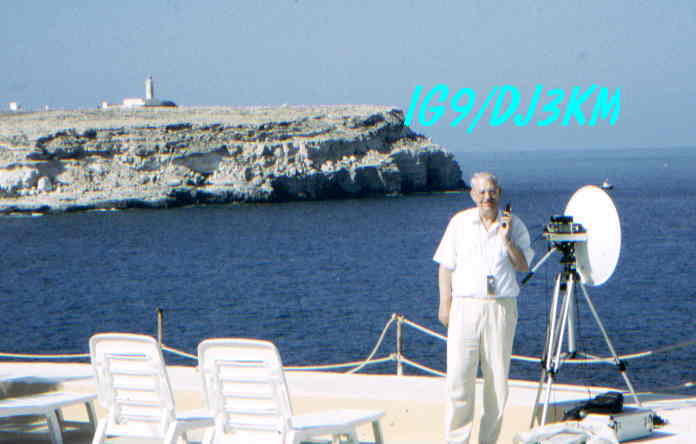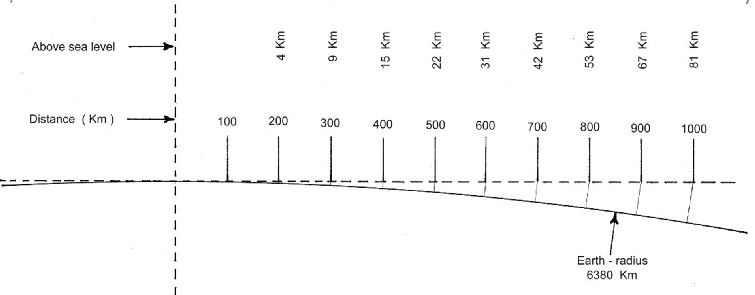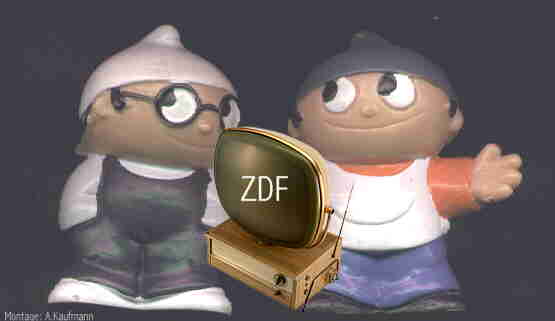
and
world record
by
IG9/DJ3KM and 4X/DJ4AM (2079 km)

Long
distance 10 GHz connections are very difficult to accomplish. The authors are
the current world record holders and would like to share some of their
experience. The importance of the utilization of special weather conditions,
forming ducts over warm water surfaces, is stressed. They lead the signal along
the earth’s surface and thus make a connection possible. The use of a very
stable transverter and high optimization of the transverter-antenna system
increase the chances of making a long distance connection. Some data on the
equipment used is presented.

Contrary to common belief, it is not necessary
to climb a high mountain for a long distance 10GHz DX. Figure 2 shows the
surface of the earth and the distance above ground of a tangent to the surface.
This is exactly what happens when a straight connection is tried between to
stations. Even for a moderate distance of 500 km the height of the positions of
the stations is unmanageable.

The workaround is to use special weather
conditions to “bend” the wavefront along the earths surface. This special
weather condition is called inversion in which tropospheric or even better
evaporation ducts can form. To take optimal advantage of these ducts the antenna
should be placed on the edge of a cliff no more than 30 m high. Even small
deviations possibly cause high loss in transmission and
make a connection impossible. Of course, the Ops must be able to
recognize the appropriate weather conditions.
The only body of water available in Europe that
meets the above conditions is the Mediterranean Sea. The chances for the right
weather conditions are best between May and September in this area.
Since 1995 we have tried to make connections every year, as stated above
rarely successfully. The tests were performed at different times of night and
day. Our experience is that connections were possible only around the time of
sunset.
It should be clear that all Ops involved in the
experiment must be experienced in CW, i.e. fluent communication without taking
notes. Weather can be challenging on the coast and calls for free hands.
Before actually trying for a connection the
locations should be inspected on a separate trip and the accuracy of locator
maps checked on the spot. This must be done by the same Ops who will be doing
the experiment to rule out misunderstandings and to assure precise knowledge of
the requirements. Alternative communication, e.g. mobile phones, should be
testes in the locations. All travel should be organized privately and not in
groups to allow maximum independence.
Ahead of the trip the regulations of the foreign
country should be checked. A letter of recommendation from the local radio club,
if possible also in the foreign language, can be very helpful when dealing with
local officials.
Last but not least, ample time, at least three
weeks, should be allocated for the experiment because of dependency on the
weather. Still, a strict schedule should be observed during that time.
It should be possible for the OP to move all of the equipment by himself, if the location requires even in a back-pack. Thus, not only light but also robust built and insensitivity to adverse weather conditions are required. Ground and front plate of the transverters casing are 5 mm thick. Besides robustness this is necessary since the casing is mounted on the tripod and holds the 60 cm antenna. The transverters, built by DL1RQ, contain no mechanically oscillating connections and no tin boxes, which makes them more resistant to shock. Figure 3 shows an image of the transverter and the antenna while in use in Spain.

The centerpiece of the transverters is the OCXO,
which was developed and improved over many years. Its stability allows the Ops
to specify a frequency on which they want to meet

without further scanning and without adjustment over time. This
simplifies the procedure of finding the other station. Ahead of larger
experiments equal status of development was assured for the OCXOs. Figure 4
shows the spectrum and the linearity of the transverter with technical data:
Model August 1998, IF: 435
MHz, noise at wave guide: 1.0 dB, output power: 5,5 W, input power: 12,8
V / RX: 0,285 A, TX: 2,83 A
 |

Our success in long distance connections in 10 GHz is mainly due to two items: The extremely stable OCXOs developed by DL1RQ and the utilization of ducts over warm water surfaces. Rigorous organization and planning reduce time and effort needed for success. Furthermore, the interest in the countries used for experiments motivates the participants to try again and again although chances of success are always slim.

DJ3KM, Adalbert ( Adi ) is a retired TV engineer ( ZDF ) with a lot of GHz experience and is hunting since 1978 for DX.
Mail
: [email protected]

DL1RQ, Peter is a Physicist and Mathematician. He is the design engineer in our group.
Mail :
[email protected]
DJ4AM, Dieter is a retired large system engineer ( IBM ).
Mail:[email protected]